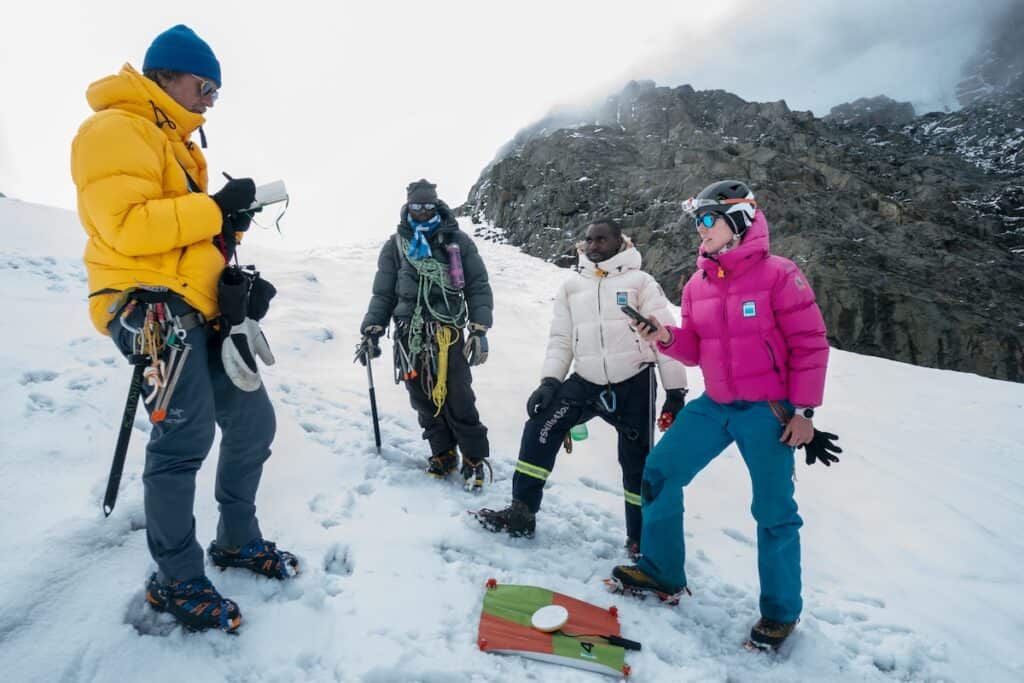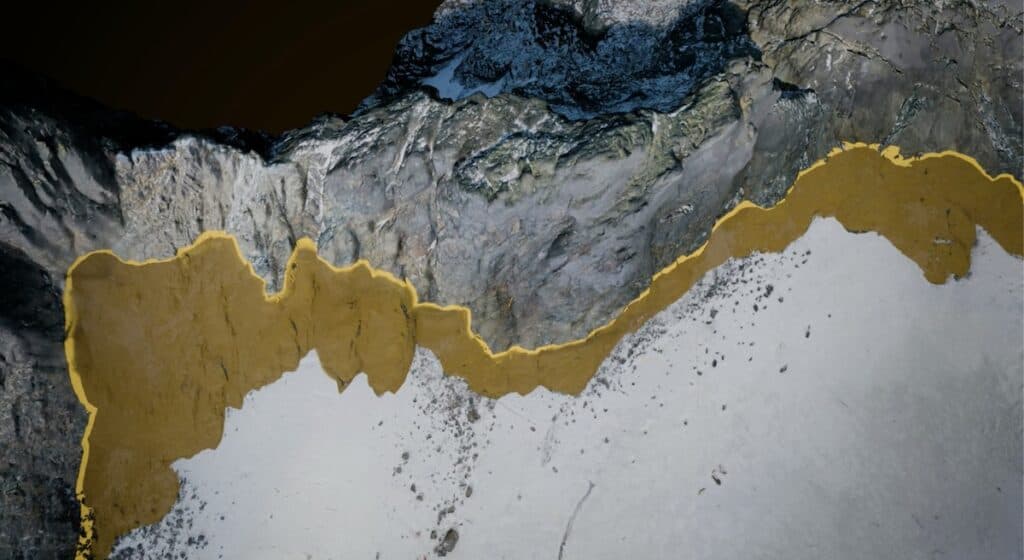
Expedition pioneers climbing the snow caps of equatorial mountains have used satellite tech and 3D models to reveal rapid ice loss in East Africa, with profound consequences for climate science and spiritual heritage.
Nestled on the border between Uganda and the Democratic Republic of Congo, the Rwenzori Mountains are a UNESCO World Heritage site and home to some of the world’s last tropical glaciers.
Project Pressure, in collaboration with UNESCO and the Uganda Wildlife Authority, led the groundbreaking expedition to the Rwenzori, surveying all three mountains (Stanley, Baker, Speke) to create the first-ever 3D model of Mount Stanley’s glaciers and install long-term monitoring equipment.
Working with local wildlife experts and experienced mountain guides, the team returned with critical mapping data, scientific measurements, and comparative imagery; plus a stark warning about the future.
Findings show that both Mt Speke and Mt Baker have lost their glaciers, while the surface of the Stanley Plateau Glacier has decreased by 29.5% since 2020 and is undergoing severe fragmentation.
Beyond the science, the loss is deeply cultural. For the Bakonzo people, the glaciers are sacred, believed to be home to their god, Kithasamba. The disappearance of the glaciers therefore signals not just an environmental crisis, but the erosion of an irreplaceable cultural heritage.
Led by Klaus Thymann, the mapping project builds on over a decade of his glaciological work, incorporating data from his expeditions in 2012, 2020, 2022, and 2024.
The findings and analysis constitute the most comprehensive record of the region’s glacial decline.
Ice source of the River Nile
The Rwenzori mountains have three main peaks, Mt Stanley, Mt Baker and Mt Speke.
The ice on Rwenzori is the highest and most permanent source of the River Nile and constitutes significant water catchment areas in Uganda — relied upon by five million people.
The Project Pressure team confirmed that the glaciers on Mt Baker and Mt Speke have now disappeared.
The highest peak, the top of Mt Stanley reaches 5,109 metres (16,762 ft), and the upper regions are still glaciated, but the ice is melting at alarming rates and will likely disappear in our lifetime.
Taken together, the expedition findings present a stark picture of glacier loss:
- Mount Speke: There is no longer a glacier on Mt Speke — although there is ice, the ice does not exhibit movement and does not deform under its own weight;
- Mount Baker: There is no longer a glacier on Mt Baker — this was already observed in 2022 and the mountain is now practically ice-free;
- Mount Stanley: The Mt Stanley glaciers are becoming fragmented — the plateau and the glaciated part of its Margarita Peak split in 2015;
- Stanley Plateau: The surface area of Stanley Plateau glacier reduced by 29.5% 2020-2024; the glacier has dropped by eight metres; and the current melting point is now mostly, if not all, above the plateau.
Data that is detailed and specific to the location is vital, explains expedition leader Klaus Thymann:
“In a world where the impact of climate change is not uniformly distributed, acquiring data on glacier recession in equatorial regions has become paramount. This is invaluable for comprehending local warming trends and their consequences to help local communities adapt.”

Geospatial tech underpins 3D model
To learn more, the team used geospatial technologies from sustainable solutions company Trimble to create the first 3D model of the last remaining glacier on the Stanley Plateau.
In particular, the small, lightweight, and easy-to-use Trimble Catalyst GNSS positioning service was key to success. Global Navigation Satellite System (GNSS) technology can access multiple satellite systems to deliver high-precision points — essential for this complex environment.
Using the Trimble tech, precise geolocation points were installed and data was captured at multiple sites — providing the foundational data that underpins the entire 3D photogrammetry model. This solution was critical in anchoring the high-resolution drone imagery to exact coordinates. Over several days, more than 850 images were captured, including all geolocation points, ensuring the model’s spatial accuracy.
Despite challenging mountain conditions, the data collection was successful with support from the Bakonzo team local mountain guides Solomon Kule and Muhindo Rogers.
These are the first high-precision 3D glacier models in the region.
To deepen the research, Dr Heïdi Sevestre conducted ground-penetrating radar surveys of the ice and bedrock — also a first here — with analysis led by the Andrea Blindenbacher team in Switzerland.
Spiritual beliefs and cultural implications
For the Rwenzori’s Bakonzo people, loss of the ice has enormous cultural implications.
The Bakonzo hold deep spiritual beliefs that are intricately connected to the natural landscape, particularly the snow-capped peaks. A central belief is that their gods, Kithasamba and Nyabibuya, reside in the ice.
For centuries, this spiritual connection has influenced how the Bakonzo interact with their environment, reinforcing conservation efforts and the sustainable use of natural resources.
The cultural impact is of glacier loss is massive, says Uganda Wildlife Authority’s Alfred Maserka:
“The Bakonzo who live among the mountains are strong people who believe the mountain is a very important aspect of their life. Disappearance of the ice is bad news because it means our gods are being destroyed.”
Next steps in local empowerment
So, what’s next for the glaciers of the Rwenzori Mountains?
As the ice retreats, Project Pressure continues to work with the Uganda Wildlife Authority to improve glacial estimates, create mitigating strategies, and expand local capacity for ongoing research and surveys.
Ongoing work includes developing more sophisticated 3D-monitoring capabilities by placing time-lapse cameras in different, overlapping locations.
Most importantly, it involves empowering local people — those who already know their environment best — to analyse and deepen our understanding of this rapidly transforming landscape.
This will help build upon the key achievements of the pioneering expedition, which were as follows:
- Created the first-ever 3D model of Mt Stanley and its glaciers;
- Installed time-lapse cameras to monitor glacial retreat;
- Empowered local community with technical monitoring capabilities;
- Generated detailed findings expected to feature in a peer-reviewed publication in late 2025.
The expedition was supported by Parajumpers, Rolex Perpetual Planet Initiative, Trimble and Guideline Geo.
Field-building for environmental activism
Project Pressure is a charity with an ecological and climate focus. Its mission is to create impactful projects that triangulate art, science, and activism resulting in actions on environmental issues.
Project Pressure has more than 15 years of experience in instigating, conceptualising, and leading ambitious change-driven projects with an emphasis on field-building. Materials from its projects have been used by activists, policymakers, institutions, and others to support their ongoing work.
Science and expedition lead Klaus Thymann is a Danish explorer, environmental scientist, award-winning photographer, journalist, and filmmaker. He is a Fellow of both the Explorers Club and the Royal Geographical Society, and a consulting scientist with DTU and Stockholm University. Thymann has led over 60 expeditions across six continents, making significant discoveries and advancing environmental research.
Andrea Blindenbacher is a Remote Sensing and GIS expert specialising in drone technology, mapping, and 3D modelling. Blindenbacher, who built the 3D model for the expedition, transforms complex datasets into detailed 3D representations of natural landscapes.
A Glaciologist and specialist in ground penetrating radar (GPR), Dr Heïdi Sevestre conducted the GPR data collection. She is currently working at the Secretariat of AMAP, the Arctic Monitoring and Assessment Programme; and was guided on the mountain by Mumbere Johnson.
The team of local mountain guides helped set up the GPS targets that underpin the geospatial structure of the 3D model. On the glacier were Kule Jocknus Bwabu Solomon, Muhindo Rogers and Thembo Lazarus. Uganda Wildlife Authority leadership was provided by Alfred Masereka, George Businge and John Makombo.
Further Reading:
- More about Project Pressure; also expedition collaborators UNESCO and the Uganda Wildlife Authority;
- More about technology solutions company Trimble; and its Trimble Catalyst GNSS positioning service;
- Also on SustMeme, Nature-based solutions on the rise in Africa;
- Also on SustMeme, Continent-wide study of plant life in Antarctica;
- Also on SustMeme, Crowdsourcing waste clean-up on Mount Everest;
- Also on SustMeme, Giant iceberg the size of Los Angeles breaks off Antarctica;
- Also on SustMeme, Guest Blog: How cutting short car trips helps save ice caps.
Check out the full archive of stories on the SustMeme Climate & Energy Channel, now available to Sponsor.

